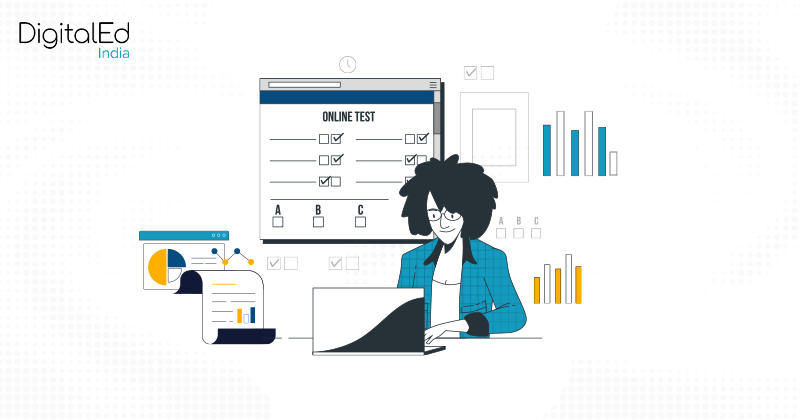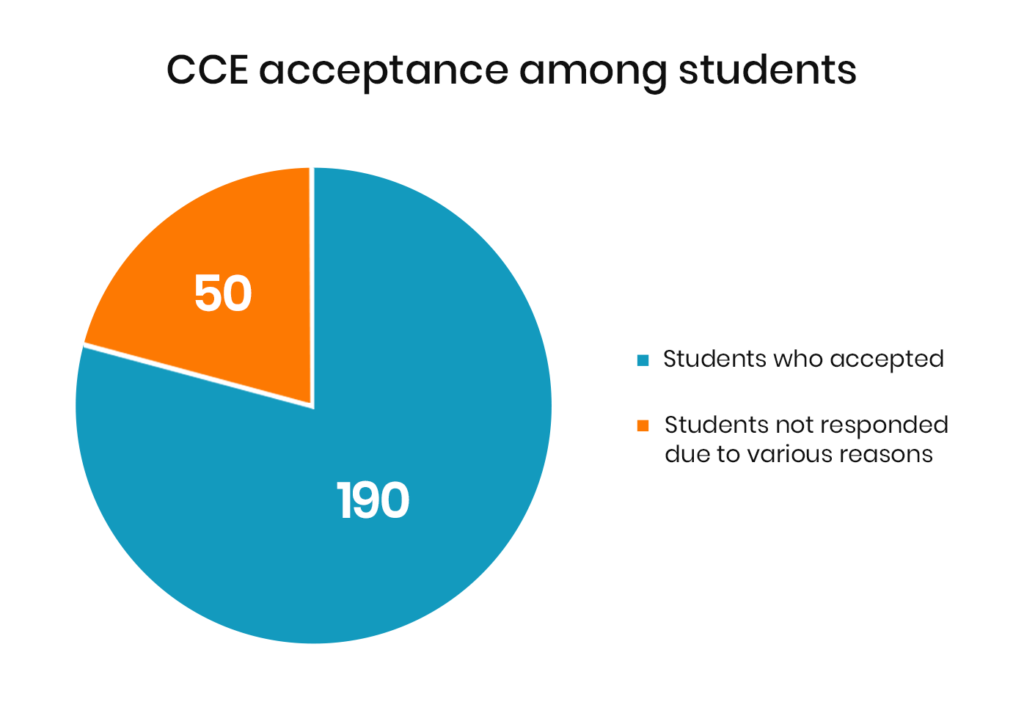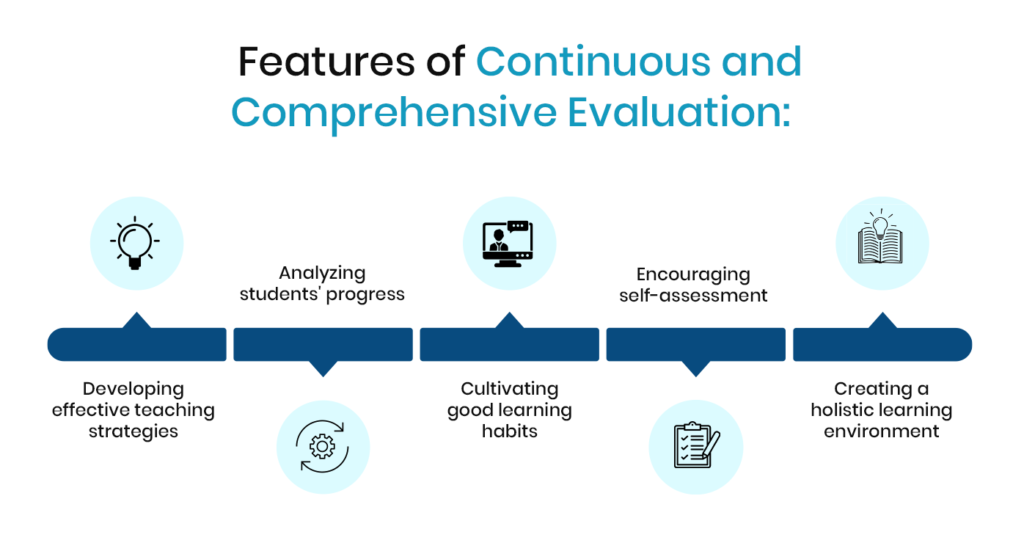What is Continuous and Comprehensive Evaluation (CCE) – A Quick Guide
In order to understand the significance and benefits of CCE (Continuous and Comprehensive Evaluation), we need to understand its place in a conventional education approach.

Traditional classroom teaching is an essential part of a student’s learning experience. However, without adequate evaluation and feedback, learners may get disconnected from the already taught concepts of a subject. This leads to unidentified knowledge gaps and a lack of interest among students.
A holistic method is essential for delivering effective student learning, and this can be achieved with a blended learning atmosphere. Blended learning can be defined as an educational approach that aims to deliver a holistic learning experience by combining traditional classroom learning and outside-the-class learning by leveraging the integration of technology and online platforms.
Educators cannot rely only on exams to deliver impactful learning experiences in higher education. Students require whole development throughout their courses, and that can only be ensured if educators pay focus on the following factors:
· Cognitive skills
· Affective skills
· Psychomotor skills
Continuous and Comprehensive Evaluation is an effective strategy that can transform the existing chalk-and-talk method of teaching and learning.
Let’s discuss this further.
What is CCE (Continuous and Comprehensive Evaluation)
The primary goal of CCE is the evaluation and assessment of every facet of the students. Continuous signifies that rather than being a one-time event, the evaluation of the highlighted characteristics of a student’s growth and development is an ongoing activity. It spans the full academic session and is integrated into the teaching and learning process. Comprehensive denotes that the approach makes an effort to address both academic and extracurricular aspects of the students.
According to a survey conducted by researchgate, 190 out of 240 students accepted CCE due to the internal grading system, and educators believed that the CCE approach promotes a higher quality of knowledge and understanding.

The Central Board of Secondary Education of India and the state governments in India directed this proposal under the Right to Education Act in 2009.
Using a variety of evaluation and assessment tasks, teachers can use CCE to identify the weaknesses of their students. Learners receive useful feedback following the completion of the assessment exercises. This helps the students to bridge different knowledge and skill gaps.

Importance of Continuous and Comprehensive Evaluation
Here are some valuable aspects of education that can be easily unlocked with CCE:
- Holistic Development
It considers all aspects of a student’s learning, including emotive, cognitive, and psychomotor. It guarantees that learners continue to learn and develop outside of the classroom since it motivates students to achieve success through continuous and consistent practice.
- Optimizing Learning Outcomes
With the process of continuous and comprehensive evaluation in education, teachers can make sure that students are able to recognize their weaknesses and take steps to enhance their learning habits. Also, with numerous tests spread out in the courses, it was thought that this would assist in relieving the pressure before and during exams.
- Personalized Education
Educators can employ the finest tactics in the classroom to fit the needs of each student. Furthermore, universities would be able to make educated decisions for their students and provide the optimal learning environment for them.
- Enhanced Teaching Strategies
CCE assists educators in systematizing their teaching practices. Continuous evaluation and assessment in education help them gain a deeper understanding of the student’s capabilities and provide feedback whenever and wherever necessary.
Objectives of Continuous and Comprehensive Evaluation
The implementation of CCE must be focused towards the following aspects:
- Cultivating a positive attitude towards education
One of the key goals of assessment and evaluation in education is to instill a good attitude toward learning. It seeks to reduce the stress and worry that students experience by increasing confidence through self-evaluation.
- The Overall progress of students
By properly grooming students, they are better prepared to confront problems. The evaluation procedure enables pupils to be physically and mentally fit, as well as socially prepared. Furthermore, The CCE patterns allow students to release their creative capabilities in addition to their academic abilities
- Development of essential life skills
It is crucial that universities give pupils a space to grow their life skills. Life skills are necessary to differentiate themselves from competitors, regardless of the career path they select. It enables people to secure better jobs and seize greater opportunities.
- Enhancing STEM courses
STEM courses include some of the most complex and hard-to-grasp concepts and subjects, and students are required to have enough confidence to execute heavy calculations and solve difficult problems effortlessly. Hence, continuous and comprehensive evaluation can be an effective approach to STEM education. This approach can help students identify their own weaknesses, practice complex problems repeatedly, and gain valuable feedback from instructors throughout the entire learning process.
Let’s discuss how to effectively implement the CCE pattern within STEM courses using the Möbius platform.
Implementing Continuous and Comprehensive Evaluation with the Möbius Platform
CCE is an essential part of STEM education. Without the process of a continuous and comprehensive evaluation, STEM student learning suffers from disinterest and knowledge breakdowns.
Unlike other e-learning platforms, Möbius lessons are not delivered as a PDF. The content on Möbius promotes an innovative blended learning approach.
STEM students can take advantage of this platform to practice randomized questions and gain confidence in the process. Also, adaptive questions (open-ended questions) can be added to understand how the students are perceiving the gained knowledge.
Educators can add questions in-between lessons, and provide quizzes, tests, etc. to test the knowledge of the students and identify potential knowledge gaps.
The interactive Möbius platform provides an effective ecosystem for CCE by allowing students to self-evaluate during the lessons, facilitating automated grading to save educators time, and helping them to gain deeper insight into every student’s progress with in-line questions.
Möbius is a product of DigitalEd, an ed-tech company with a resonant purpose- simplifying STEM education for teachers and students all over the globe.
Contact us to learn more.